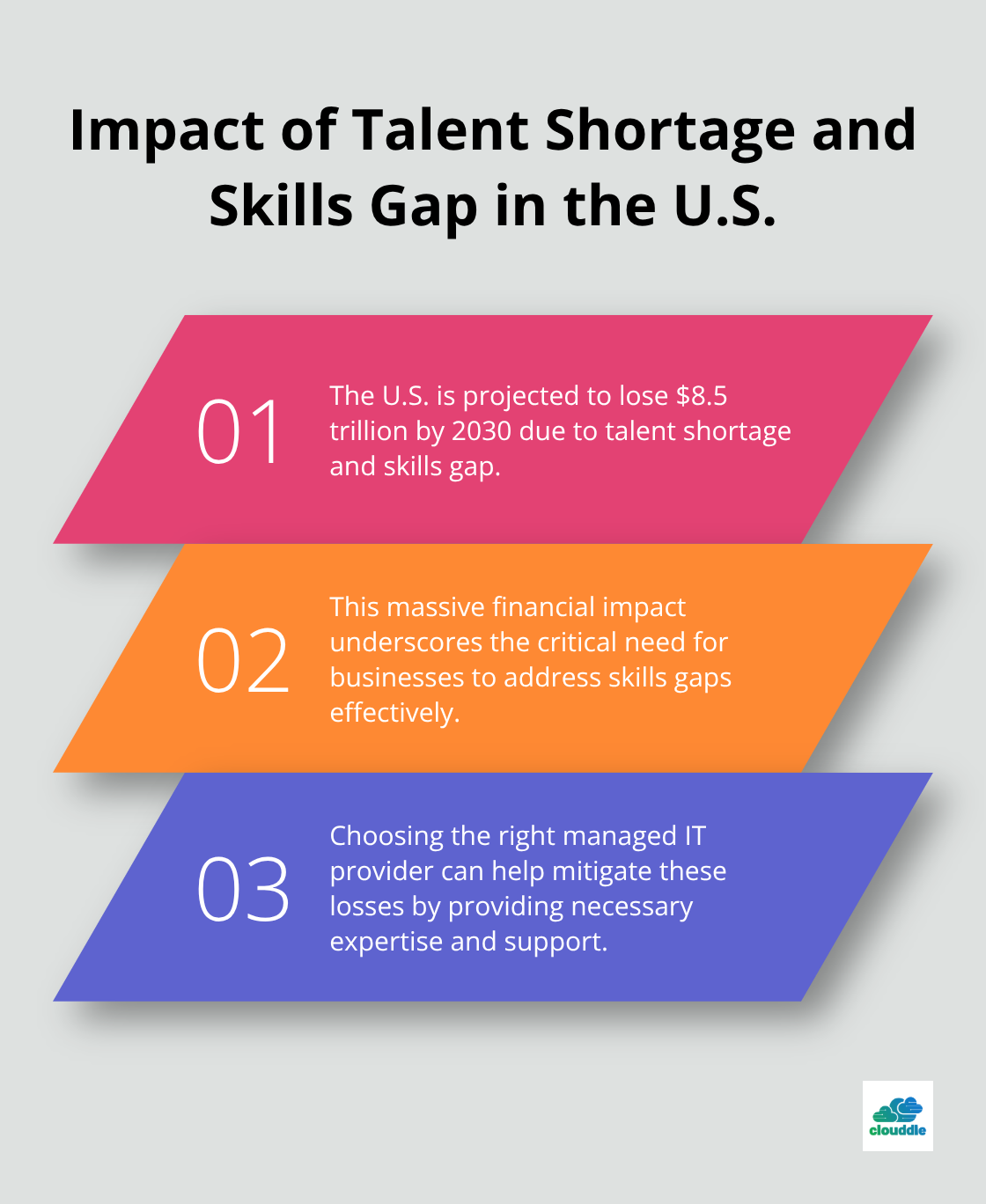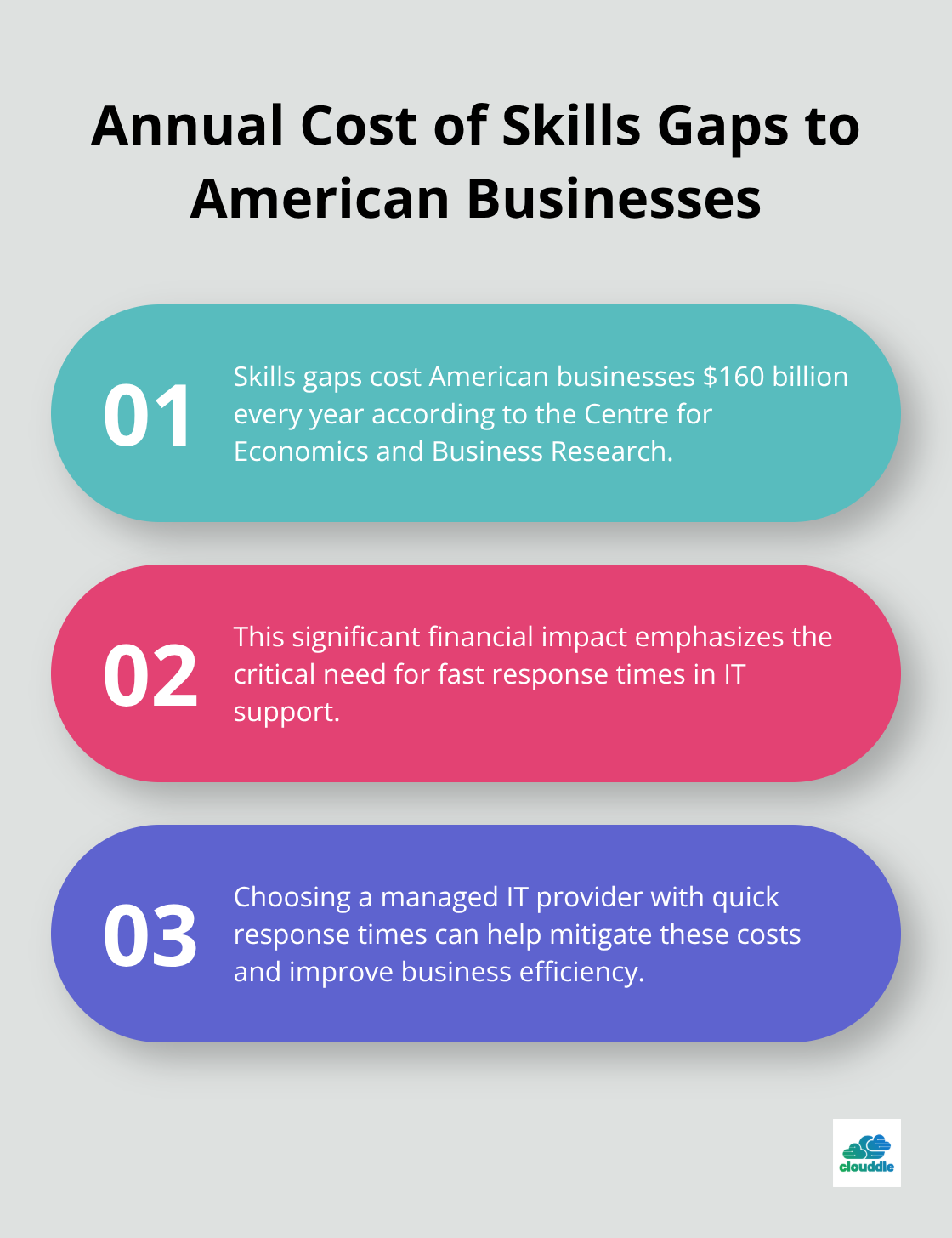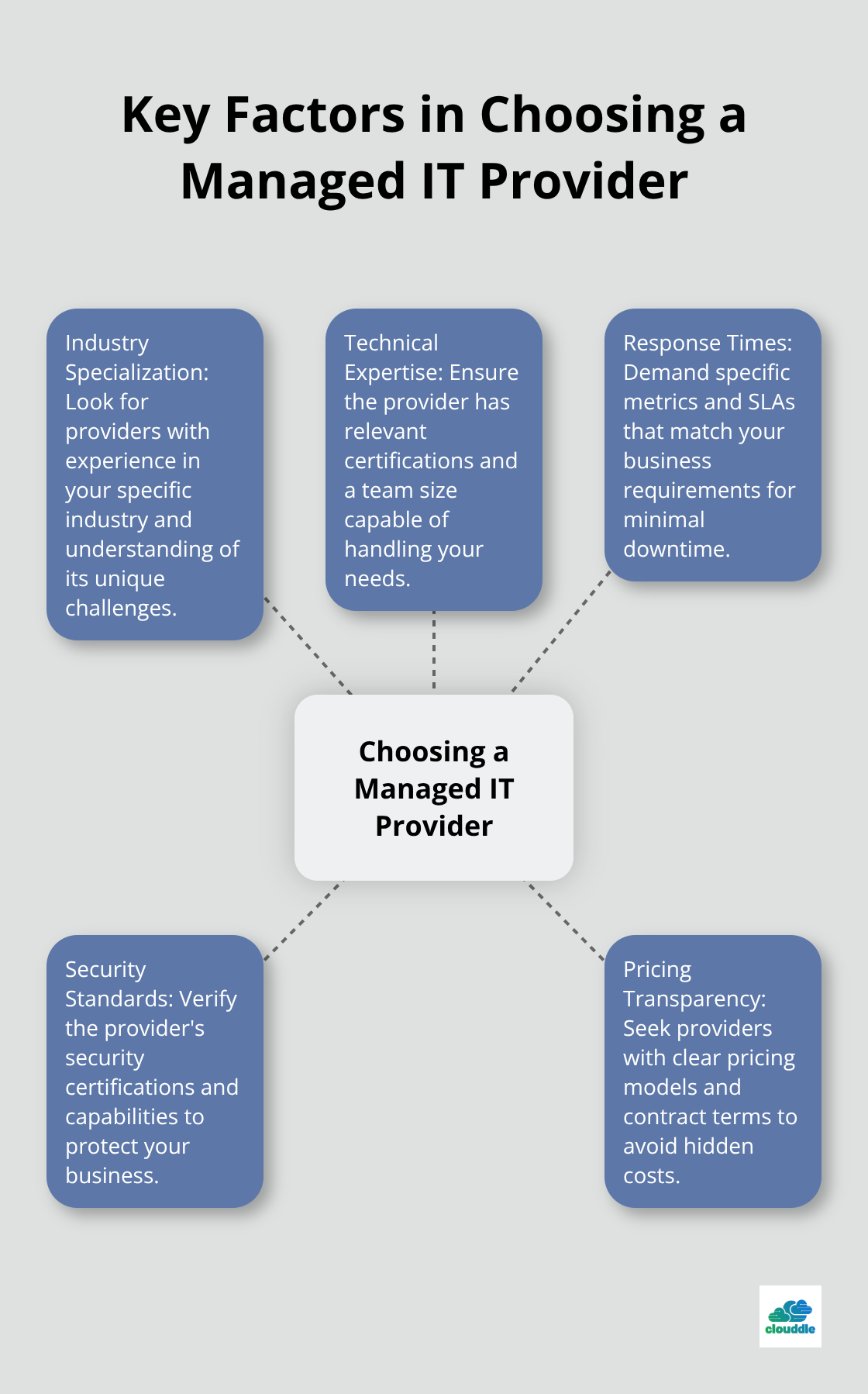Selecting the right managed IT provider can make or break your business operations. Poor choices lead to downtime, security breaches, and frustrated employees.
We at Clouddle understand that knowing how to choose a managed IT provider requires careful evaluation of multiple factors. The right partnership transforms your technology from a headache into a competitive advantage.
What Are Your Real IT Requirements
Most businesses skip the foundation step and jump straight to vendor selection. This backwards approach wastes months and thousands of dollars on mismatched solutions.
Start With Your Current Technology Problems
Document every IT issue your team encounters weekly. Track downtime incidents, security concerns, and employee complaints about slow systems. According to research, the talent shortage and skills gap in the U.S. alone is expected to total a loss of $8.5 trillion by 2030. Identify which problems stem from outdated hardware, insufficient support, or missing expertise. Write down specific pain points like server crashes during peak hours, Wi-Fi dead zones that affect customer experience, or backup failures that put your data at risk. This concrete list becomes your vendor evaluation checklist.

Map Your Growth Timeline and Technology Needs
Your IT requirements change dramatically as you scale. A 50-employee company needs different infrastructure than a 500-employee operation. Define your headcount projections for the next three years and calculate corresponding bandwidth, storage, and security requirements. Consider expansion plans, new locations, and regulatory changes in your industry. If you operate in healthcare, financial services, or other regulated sectors, compliance requirements drive specific technology choices that generic providers cannot handle effectively.
Define Service Levels That Match Your Operations
Response times matter more than promises. Determine what constitutes an emergency for your business and set realistic expectations. Manufacturing companies cannot tolerate four-hour response times during production shifts, while professional services firms might accept next-business-day support for non-critical issues. Specify whether you need monitoring capabilities, on-site support, or remote assistance. Request specific metrics from potential providers including response times, system uptime percentages, and escalation procedures for critical incidents.
Once you understand your exact requirements, you can evaluate providers based on their ability to meet these specific needs rather than generic capabilities.
What Makes a Provider Worth Your Investment
Technical expertise separates competent providers from those who will cost you money and headaches. Look for certifications from Microsoft, Cisco, AWS, and other major vendors that match your technology stack. A provider who manages Office 365 environments should hold Microsoft Gold Partner status, not basic certifications.
Check their team size and specialization depth. Companies with fewer than 10 engineers cannot provide 24/7 coverage or handle complex emergencies effectively. Ask for specific examples of infrastructure they manage similar to yours.
Industry-Specific Experience Matters
Manufacturing companies need providers experienced with industrial networks and SCADA systems, while healthcare organizations require HIPAA expertise and medical device integration knowledge. Generic IT support fails when specialized systems break down.
Providers who serve your industry understand regulatory requirements, compliance standards, and operational challenges that generic MSPs miss. A provider who manages retail point-of-sale systems knows how to handle Black Friday traffic spikes, while those serving financial firms understand trading system uptime requirements.
Response Times That Match Your Business Reality
Service Level Agreements determine whether downtime costs you thousands or millions. Standard SLAs that promise four-hour response times sound reasonable until your point-of-sale system crashes during peak sales periods.
Demand specific metrics: 15-minute response for critical issues, two-hour resolution for server problems, and next-business-day for routine requests. According to the Centre for Economics and Business Research, skills gaps cost American businesses $160 billion every year, making fast response times financially critical.

Verify their escalation procedures and ask for performance reports from existing clients. Providers who cannot show consistent uptime above 99.5% or average resolution times under their promised SLAs will fail during your emergencies.
Security Standards That Protect Your Business
Security certifications reveal whether a provider takes cybersecurity seriously or treats it as an afterthought. SOC 2 Type II compliance demonstrates audited security controls, while ISO 27001 certification shows systematic information security management.
Providers who handle financial data need PCI DSS compliance, and those who serve healthcare clients must understand HIPAA requirements beyond basic training. Ask about their security assessment capabilities, incident response procedures, and threat monitoring tools.
Companies without dedicated security teams or 24/7 monitoring capabilities cannot protect against modern cyber threats that evolve hourly. Understanding managed services IT pricing models helps you evaluate whether providers can deliver on their promises while fitting your budget constraints.
What Questions Separate Good Providers From Great Ones
The wrong questions waste your time on generic sales pitches while the right ones reveal whether a provider can handle your specific challenges. Most businesses ask about pricing first and technical capabilities second, which explains why many companies switch managed service providers within a few years.

Industry Specialization and Experience
Start with industry specialization because generic providers fail when specialized systems need support. Healthcare organizations need providers who understand HIPAA compliance beyond basic training, while manufacturing companies require expertise with industrial control systems and SCADA networks. Financial services firms need providers experienced with trading platforms and regulatory reporting systems.
Ask for specific client examples in your industry and request to speak with references who face similar operational challenges. Providers who cannot name at least three clients in your sector or provide relevant case studies lack the specialized knowledge your business requires.
Emergency Response and Downtime Management
Emergency response procedures reveal whether providers understand your business reality or operate from generic playbooks. Ask how they handle server failures during peak business hours, what their escalation process looks like for critical system outages, and whether they maintain spare equipment for immediate deployment.
Demand specific response time commitments with financial penalties for missed targets. Manufacturing companies cannot accept four-hour response times during production shifts, while retail operations need immediate support during Black Friday sales periods (when revenue peaks). Request their after-hours contact procedures and verify they maintain 24/7 staffing rather than outsource emergency calls to third-party answering services.
Pricing Models and Contract Terms
Pricing transparency separates honest providers from those who hide costs in complex contracts. Monthly fixed pricing with clearly defined services works better than per-incident billing that creates unpredictable expenses. Ask about onboarding fees, contract termination costs, and charges for additional services beyond the base agreement.
Providers who cannot provide detailed pricing breakdowns or refuse to discuss contract terms upfront typically add hidden charges later. Request sample contracts and compare service level agreements across multiple providers to identify which ones offer genuine value versus those that promise low rates but charge extra for basic support tasks (like after-hours assistance or security updates).
Final Thoughts
Your decision on how to choose a managed IT provider determines whether technology supports or hinders your business growth. Prioritize providers who demonstrate expertise in your industry, maintain certified technical teams, and offer transparent pricing with strong service agreements. The best providers maintain 99.5% uptime or higher and provide detailed performance metrics that prove their capabilities.
Contract terms require as much attention as technical capabilities. Avoid providers who hide costs in complex agreements or charge excessive fees for basic services. Monthly fixed pricing models with clearly defined service levels and reasonable termination clauses protect your business from unexpected expenses.
Implementation success depends on thorough onboarding and clear communication channels. Establish regular review meetings to track performance against agreed metrics and adjust services as your business evolves. We at Clouddle specialize in managed IT solutions with comprehensive support services designed to support your growth objectives.


